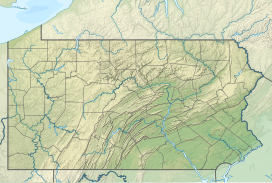Savage Mountain
| Savage Mountain | |
|---|---|
 Wind farm on the summit, near Pleasant Union, Pennsylvania | |
| Highest point | |
| Elevation | 2,667 ft (813 m)[1] |
| Dimensions | |
| Length | 30 mi (48 km) |
| Naming | |
| Etymology | eponym: John Savage |
| Geography | |
| Country | United States |
| States | Maryland and Pennsylvania |
| Counties | Allegany MD, Bedford PA, Garrett MD and Somerset PA |
| Range coordinates | 39°53′11″N 78°44′10″W / 39.88639°N 78.73611°W |
| Parent range | Ridge-and-Valley Appalachians |
| Geology | |
| Orogenies | Alleghenian orogeny (the western edge of the Allegheny Formation "shows along the eastern slope of Savage Mountain".) |
| Mountain type | anticline |
| Rock type | Carboniferous:[2] "Mauch Chunk Red Shales and Limestones" |
Savage Mountain is an anticline extending from Bedford County, Pennsylvania southwest into Western Maryland.[3] It is the western side of the Ridge-and-Valley Appalachians, and the eastern portion of the ridge forms the border of Garrett and Allegany Counties of Maryland.
The anti-cline includes two parallel component ridges: Little Savage Mountain to the west and Big Savage Mountain to the east. Little Savage Mountain becomes Allegheny Mountain to the north at a saddle near Meyersdale, while Big Savage Mountain becomes Backbone Mountain to the south at the Savage River Reservoir.
Portions of Savage Mountain form the Eastern Continental Divide, separating watersheds draining to the Ohio River and those draining to the Potomac. To the northwest of Savage Mountain, waters drain to the Casselman River. The North Branch Potomac River watershed encompasses the southwestern and eastern portions of the ridge.
History
[edit]After Nemacolin's Path and the first survey of the Potomac (1736–1737) had passed through the area, the Braddock Road over the ridge opened in 1757. By 1767, the Mason–Dixon line survey had placed milestones across the ridge[4][5] and the National Road was completed through the area by 1818.

In 1911, construction began on the Borden and Big Savage Tunnels for the Connellsville subdivision of the Western Maryland Railway. In the 1930s, the Civilian Conservation Corps built a connection road that is now the 6.4 mile Monroe Run Trail.[6]
The Savage River Dam and Reservoir were constructed just southwest of the ridge in 1952 to control flooding along the Savage River and North Branch Potomac River, as well as to supply water to nearby communities.[7]
On August 13, 1976, the freeway that would become Interstate 68 opened through the ridge.[8] Due to severe fog conditions common along this stretch of highway, Maryland's first "fog warning system" was installed after a May 2003 crash that killed two and injured about 100 people.[9][10]
In 2001, the fire history and dendroecology of Savage Mountain oak stands were investigated.[11] About 2,600 trees were later planted in the Savage Mountain Demonstration Plot #2 in 2007.[12]
Wind power
[edit]In 2006, U.S. WindForce proposed a 40-megawatt (54,000 hp)wind farm on Savage Mountain at a strip-mining site.[13] A study for the Savage Mountain Transmission Main Project began in 2008.[14]
Notable points
[edit]| Point | Location | Elevation |
|---|---|---|
| CSX Transportation railroad | 39°48′30″N 78°57′27″W / 39.80833°N 78.95750°W | 2,430 feet (741 m) |
| Big Savage Mountain | 39°47′40″N 78°49′47″W / 39.79444°N 78.82972°W | 2,566 feet (782 m) |
| Big Savage Tunnel | 39°44′27″N 78°53′37″W / 39.74083°N 78.89361°W | 2,400 feet (732 m) (above tunnel) |
| Little Savage Mountain | 39°43′49″N 78°55′11″W / 39.73028°N 78.91972°W | 2,820 feet (860 m) |
| Maryland/Pennsylvania state line (Mason–Dixon line) | 39°43′21″N 78°54′51″W / 39.72250°N 78.91417°W | 2,840 feet (866 m) |
| U.S. Route 40 Alternate | 39°40′56″N 78°58′01″W / 39.68222°N 78.96694°W | 2,847 feet (868 m) |
| Interstate 68/U.S. Route 40 | 39°40′23″N 78°57′46″W / 39.67306°N 78.96278°W | 2,830 feet (863 m) |
| Elbow Mountain | 39°34′06″N 79°05′10″W / 39.56833°N 79.08611°W | 2,740 feet (835 m) |
References
[edit]- ^ a b "Savage Mountain". Geographic Names Information System. United States Geological Survey, United States Department of the Interior. August 2, 1979. Retrieved May 31, 2010.
- ^ Stevenson, J. J (1882). The Geology of Bedford and Fulton Counties. Board of Commissioners. p. 95. Retrieved 2009-12-06.
{{cite book}}:|work=ignored (help) - ^ "Google Maps". Maps.Google.com.
{{cite journal}}: Cite journal requires|journal=(help) Except when available at another wikiarticle or cited otherwise, Google Maps is the source for coordinates in this article:
Savage Mountain (MD), Savage Mountain (PA), Sand Patch Tunnel, Little Savage Mountain - ^ "Maryland Inventory of Historic Properties: Allegany County". Maryland Historical Trust. Retrieved January 4, 2010.
- ^ "Maryland Inventory of Historic Properties: Garrett County". Maryland Historical Trust. Retrieved January 4, 2010.
- ^ "New Germany, Casselman River Bridge & Big Run State Parks" (PDF). Maryland Department of Natural Resources. Retrieved January 4, 2010.
- ^ "Savage River Tailwater Trophy Trout Fishing Area". Fisheries. Maryland Department of Natural Resources. Retrieved 9 September 2016.
- ^ "Building the National Freeway". Maryland Roads. Maryland State Highway Administration. 1991-08-02.
- ^ Small, George (2005-05-05). "2005 National Highway Visibility Web Conference featuring the I-68 Fog Warning System" (PDF). FHWA.DOT.gov. Archived from the original (PDF) on October 4, 2006. Retrieved 2009-11-16.
- ^ "Maryland's I-68 re-opens after huge pileup". CNN.com. 2003-05-24. Retrieved 2008-09-07.
- ^ Shumway, Durland L.; Marc D. Abrams; Charles M. Ruffner (2001). "A 400-year history of fire and oak recruitment in an old-growth oak forest in western Maryland, U.S.A." Canadian Journal of Forest Research. 31 (8): 1437–1443. doi:10.1139/cjfr-31-8-1437. Retrieved January 4, 2010.
- ^ "ARRI Arbor Day Events". Appalachian Regional Reforestation Initiative. Retrieved January 4, 2010.
- ^ Ridder, Mona (April 2007). "Wind farm under construction near Mt. Storm" (PDF). The Highlands Voice. 40 (4). West Virginia Highlands Conservancy: 15.
- ^ "November 2008 Council Minutes". City of Frostburg, Maryland. Retrieved January 4, 2010.
See also
[edit]- Eastern Continental Divide
- Georges Creek Valley
- K2 (sometimes called "the Savage Mountain")

